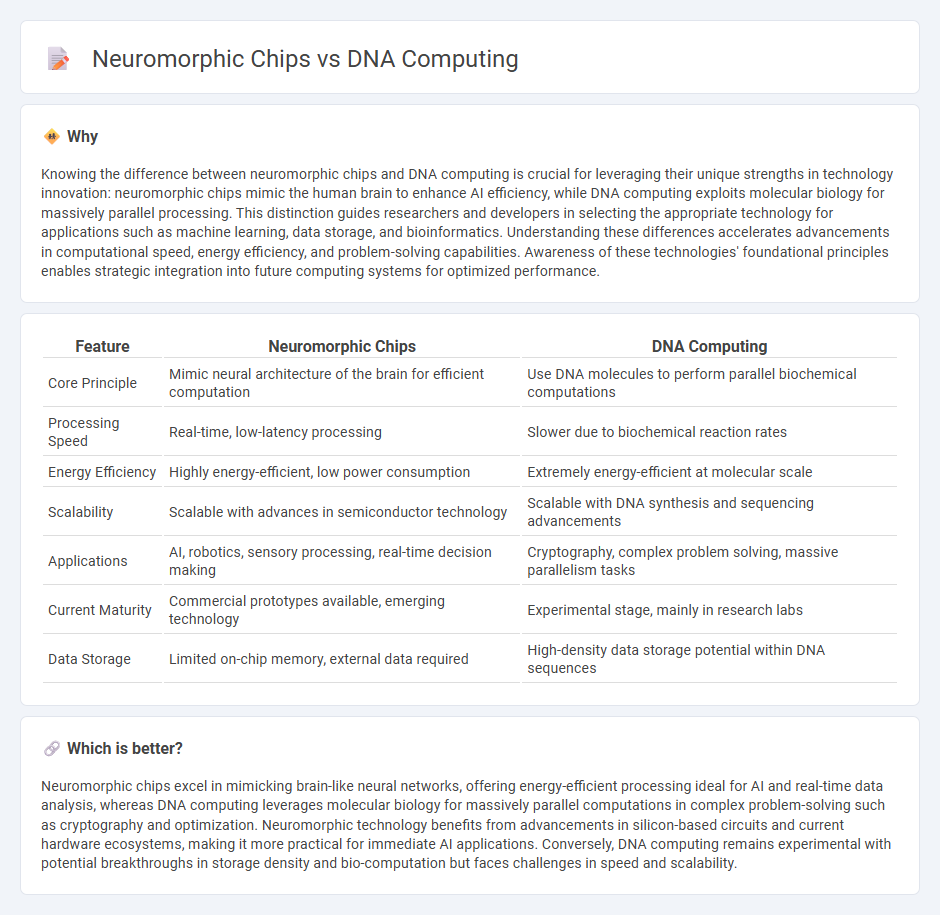
Neuromorphic chips mimic the human brain's neural architecture to enable energy-efficient, real-time processing ideal for AI applications, while DNA computing leverages biological molecules to perform complex computations at a molecular level, offering immense parallelism and data storage capacity. Both technologies promise breakthroughs in solving problems beyond the reach of classical silicon-based processors, particularly in machine learning and nanoscale data manipulation. Explore deeper insights into how neuromorphic chips and DNA computing are revolutionizing the future of information technology.
Why it is important
Knowing the difference between neuromorphic chips and DNA computing is crucial for leveraging their unique strengths in technology innovation: neuromorphic chips mimic the human brain to enhance AI efficiency, while DNA computing exploits molecular biology for massively parallel processing. This distinction guides researchers and developers in selecting the appropriate technology for applications such as machine learning, data storage, and bioinformatics. Understanding these differences accelerates advancements in computational speed, energy efficiency, and problem-solving capabilities. Awareness of these technologies' foundational principles enables strategic integration into future computing systems for optimized performance.
Comparison Table
| Feature | Neuromorphic Chips | DNA Computing |
|---|---|---|
| Core Principle | Mimic neural architecture of the brain for efficient computation | Use DNA molecules to perform parallel biochemical computations |
| Processing Speed | Real-time, low-latency processing | Slower due to biochemical reaction rates |
| Energy Efficiency | Highly energy-efficient, low power consumption | Extremely energy-efficient at molecular scale |
| Scalability | Scalable with advances in semiconductor technology | Scalable with DNA synthesis and sequencing advancements |
| Applications | AI, robotics, sensory processing, real-time decision making | Cryptography, complex problem solving, massive parallelism tasks |
| Current Maturity | Commercial prototypes available, emerging technology | Experimental stage, mainly in research labs |
| Data Storage | Limited on-chip memory, external data required | High-density data storage potential within DNA sequences |
Which is better?
Neuromorphic chips excel in mimicking brain-like neural networks, offering energy-efficient processing ideal for AI and real-time data analysis, whereas DNA computing leverages molecular biology for massively parallel computations in complex problem-solving such as cryptography and optimization. Neuromorphic technology benefits from advancements in silicon-based circuits and current hardware ecosystems, making it more practical for immediate AI applications. Conversely, DNA computing remains experimental with potential breakthroughs in storage density and bio-computation but faces challenges in speed and scalability.
Connection
Neuromorphic chips and DNA computing both leverage bio-inspired architectures to revolutionize data processing efficiency and parallelism. Neuromorphic chips mimic neuronal structures to enhance artificial intelligence capabilities, while DNA computing utilizes molecular mechanisms for massively parallel computation at a nanoscale. Integrating these technologies promises breakthroughs in energy-efficient computing and complex problem-solving across fields like machine learning and synthetic biology.
Key Terms
Biochemical reactions
DNA computing harnesses biochemical reactions by utilizing the natural base pairing and enzymatic processes for parallel data processing and storage at a molecular level. Neuromorphic chips mimic neural structures through electronic circuits, emphasizing spiking neurons and synaptic plasticity without engaging biochemical mechanisms. Explore more about how these distinct approaches impact computational efficiency and adaptability.
Spiking neural networks
Spiking neural networks (SNNs) are computational models inspired by the brain's neural architecture, emphasizing timing and event-driven data processing crucial for neuromorphic chips, which mimic biological neurons using silicon-based hardware for energy-efficient performance. In contrast, DNA computing exploits molecular interactions for massively parallel computations but lacks the real-time, spike-based processing native to SNNs. Explore the advancements and implications of integrating SNNs within neuromorphic systems to enhance artificial intelligence capabilities.
Parallelism
DNA computing leverages massive parallelism through molecular reactions, enabling simultaneous processing of vast data sets with billions of DNA strands acting as computational units, vastly surpassing traditional silicon-based methods. Neuromorphic chips mimic the brain's architecture by utilizing parallel networks of artificial neurons and synapses, providing low-power, real-time processing optimized for sensory data and pattern recognition tasks. Explore the transformative potentials and unique parallelism strategies of DNA computing and neuromorphic technology to understand their future impact on computing architectures.
Source and External Links
DNA computing - Wikipedia - DNA computing is an emerging branch of unconventional computing using DNA and molecular biology hardware to perform computations, with recent advances including DNA-based neural networks and localized DNA circuits to improve computational speed.
The DNA computer: super hard drive of the future? - DNA computing exploits the four-letter genetic code (A, T, C, G) to encode information, offering vastly greater data storage density and longevity than traditional electronic memory, and aims to develop architectures enabling communication between processors and memory in DNA-based systems.
For First Time, DNA Tech Offers Both Data Storage and Computing ... - A new DNA computer has been developed that can store, retrieve, compute, erase, and rewrite data repeatedly on the same material, achieving full functionality comparable to electronic devices but at a nanoscale density far beyond traditional storage.
 dowidth.com
dowidth.com